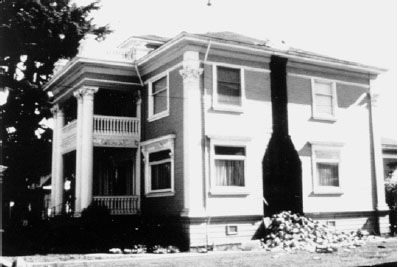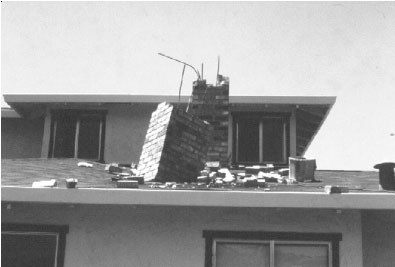The Seven Steps
Unreinforced Masonry Chimneys
The Problem
Many chimneys are built of unreinforced brick or stone. During an earthquake these can collapse or break and fall on the roof.
When the chimney fails, the falling stones and bricks can:
- Cause injuries
- Damage the house
- Damage cars
Tall slender chimneys are most vulnerable.
How to Identify
- Check the mortar between the bricks or stones with a screwdriver. If it crumbles when you pick at it, the chimney may be a hazard.
- Inspect the attic and floor spaces for metal ties that should be holding the chimney to the house.
- Determining whether a chimney is susceptible to earthquake damage is not always easy. When in doubt, consult a licensed engineer or contractor.
Remember
- Do not locate patios, children’s play areas, or parking spaces near a questionable chimney.
- Tell family members to get away from chimneys and fireplaces during earthquakes.
The Solution

Photo showing damaged chimney removed. Note that the fireplace is now not functional.
Source: Office of Emergency Services
Tear down the old or damaged chimney and replace with a newly constructed chimney.
Several steps can be taken to reduce the risk of damage from falling chimneys, depending upon the type of chimney you have. They include:
- Add plywood panels at the roof or above the ceiling joists to prevent the brick or stone from falling into the house.
- This can be done by layering plywood above the ceiling, in the house’s attic, or nailing plywood under the shingles when reroofing.
- Replace the upper chimney with metal flues.
- Strengthen the existing chimney.
- This can be a complicated process, depending upon the construction and height of the existing chimney.
Consult your local Building Department and obtain necessary permits first.
How-to Resource
- Reconstruction and Replacement of Earthquake Damaged Masonry Chimneys, City of Los Angeles, Department of Building &Safety, Information Bulletin #P/BC-2002-70.







